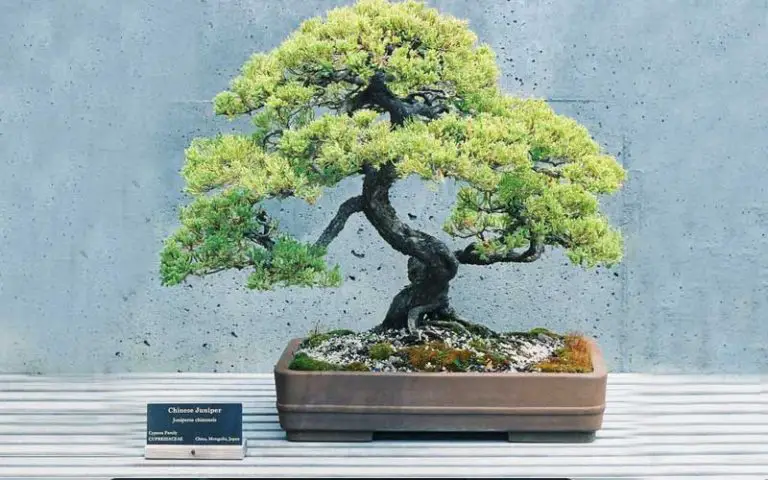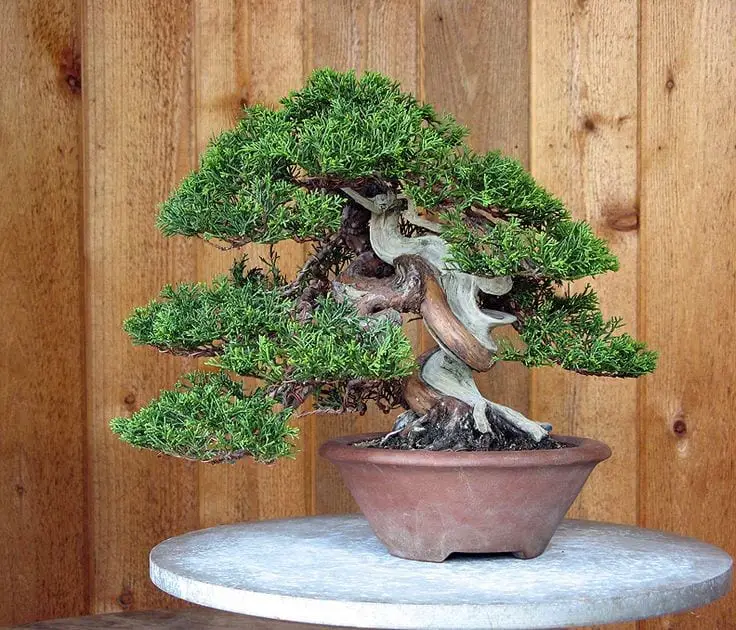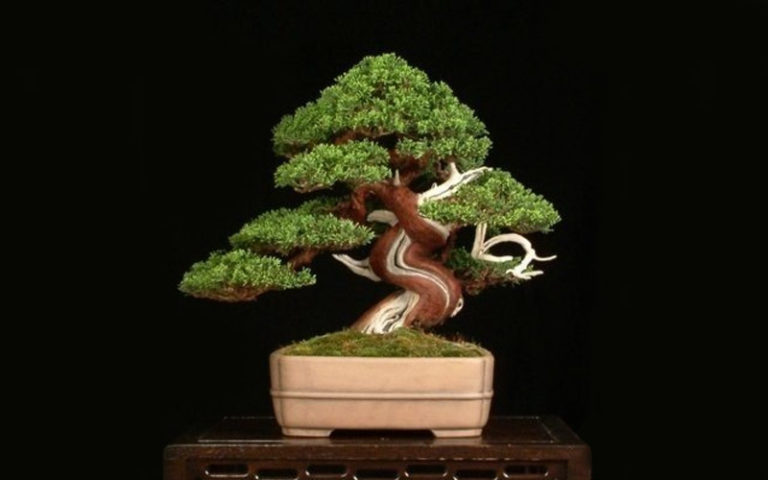Chinese Juniper Bonsai | Juniperus Chinensis

With more than 50 different varieties of Juniper bonsai trees available, the most popular varieties include the Needle Juniper and the Chinese Juniper bonsai tree. Juniperus chinensis is a species of plant in the cypress family Cupressaceae, native to China, Myanmar, Japan, Korea, and the Russian Far East.
A Chinese Juniper bonsai is an adaptable evergreen plant. It’s unique in the sense that it is one of the few bonsai trees that can be placed indoors or kept outdoors. Juniper bonsais are some of the easiest trees to care for and are very forgiving. There are many tips and tricks to caring for your Chinese Juniper bonsai, and you will find most of them in this care sheet.
Here’s what you’ll find in our Juniperus Chinensis bonsai species guide:
Here’s what you’ll find in our Juniperus Chinensis bonsai species guide:
01
02
03
04
05
06
07
Quick Chinese Juniper Bonsai Care Sheet
For a quick summary of the basics to care for your Juniperus chinensis bonsai, see the care sheet below.
Recommended soil
Well-drained light (sandy), medium (loamy), and heavy (clay) soils
Watering
Water the plant well, allow for proper drainage, and then let the soil dry before watering again. Mist the leaves regularly
Potting season
Early spring
Shaping and pruning season
Late winter or early spring
Light
Full Sun
Fertilizing
Feed the tree with half-strength liquid fertilizer once a month during the spring and fall seasons. Do not feed the juniper tree in the summer months. Do not fertilize the tree immediately after it has been re-potted.
Propagation methods
Seed or cuttings of mature wood
Pests and diseases
Mites, Scales, Aphids and Fungal Rust Disease
Growth patterns
Dark green foliage. The bark is brown, and when mature, the stems peel in strips
Recommended styles
Informal Upright and Cascade
Scientific Classification
- Scientific name: Juniperus chinensis
- Family: Cupressaceae (cypress)
- Division: Pinophyta (pine)
- Kingdom: Plantae
- Class: Pinopsida
- Order: Pinales

How to Care for a Chinese Juniper Bonsai
Chinese Juniper bonsai trees can be placed indoors or kept outdoors. They are easy to take care of and are well suited to those new to caring for a Bonsai.
Best Soil
Juniperus chinensis can grow in many different types of soil. It will grow in light (sandy), medium (loamy) and heavy (clay) soil as long as it drains relatively fast and very well. Ensure that there are a lot of drainage holes in the pot.
This bonsai is also not too fussy about soil PH levels either and can tolerate acid, neutral and basic (alkaline) to very alkaline soils. For the best results, fill your Bonsai pot with average garden soil with a neutral to slightly acidic PH.
Watering
Young Chinese Juniper Bonsai trees need to be kept moist but not waterlogged. The water needs to drain fast. Young plants can be watered once or twice a week to maintain soil moisture, but you need to monitor this depending on the tree’s location. If the tree is kept outside, you might have to water more.
An excellent way to determine the moisture level of the soil is the chopstick method. Stick a wooden chopstick into the ground about two inches deep. Remove it after ten minutes. If the chopstick is damp when removed, you do not need to water. If dry, you do.
Mature Juniperus chinensis trees do not mind drying out between watering sessions, but you still need to monitor the soil to see when you need to water. Humidity is essential, and using a spray bottle to mist the leaves will help the foliage breathe better. Use the spray bottle, especially if you have recently repotted the tree, to prevent the bonsai tree from becoming dehydrated.
Repotting
All Bonsai trees need to be reported periodically to provide them with fresh soil and to encourage a more compact root system. Typically, a Chinese Juniper Bonsai under the age of ten years should be repotted every two years. The roots need to be pruned at the same time but only moderately. Juniperus chinensis bonsai over the age of ten years should be repotted every three or four years.
Trees do grow at different rates, and it is always better to check how much the roots of your tree have filled the pot before the tree becomes pot bound.
Shaping and Pruning
Typically, it is best to prune your Chinese Juniper Bonsai annually in the late Winter or early Spring, just before growth starts to show. Cut off any dead or leggy branches to maintain the style. Thin out branches around the plant to allow light to reach its centre.
After completing the thinning stage, wire and fan out the foliage pads; otherwise, the inner areas of the foliage pads will die. Sometimes pests infest pads that are too thick. This tree can handle aggressive pruning very well.
Your Juniperus chinensis bonsai can also handle robust bending techniques for shaping. An occasional wrap with raffia could be required as protection. Take care with deadwood as this can break off. With large and old trees, it is wise to split the deadwood off as to bend the more flexible living parts.
Location and Sunlight
The Chinese Juniper Bonsai tree prefers full sun for at least six hours a day. Place it where it is in the shade in the afternoons. It does not mind temperature fluctuations and some variants handle extreme cold well.
It is one of the few bonsai trees that can be placed indoors or kept outdoors. Humidity is essential, and putting a humidity tray underneath the pot of the Juniperus chinensis bonsai tree will ensure the required high level of humidity is reached. The bonsai might die without it. The roots of the tree must not sit directly in water as this can submerge the roots and cause rotting.
Fertilizing
Treat the Chinese Juniper Bonsai tree with fertilized roughly once every three weeks. Use a fertilizer with a high level of nitrogen in Spring. In Summer, a more balanced fertilizer will work best. During Autumn, use a fertilizer that is low in nitrogen and no fertilizer while dormant in Winter.
Propagation Methods
It is possible to grow a Juniperus chinensis bonsai from seed or cuttings. However, a period of cold stratification is required for the seed. It’s slow to germinate due to its hard seed coat. Soaking the seed for 3 – 6 seconds in boiling water is recommended to speed up the germination process.
Sow the seed in a cold frame and expect some to germinate in the Spring and the rest to take another year. The seed requires a cold, warm, and then another cold of 2 to 3 months for each period to germinate. Green seeds can be used which do not have a hard coating. Seeds stored in dry conditions can remain dormant for several years.
Cuttings of mature wood can also be used to propagate a Juniperus chinensis bonsai. Cut 5 – 10cm with a heel in the winter months and keep in dry and cold conditions. Plant the cuttings in the following Autumn.
Pests and Diseases
The most common pests and diseases affecting juniper bonsai trees are Abiotic Maladies which are caused by extreme weather conditions, poor growing or cultivating conditions or the presence of other pests. Other pests that can infest your Chinese Juniper Bonsai tree are Mites, Scales, and Aphids. These occur when the foliage pads are too thick or the tree not receiving enough light, especially during Winter.
The bonsai can also be infested with spider mites, some with juniper scale, juniper aphids, juniper needle miners, and juniper webworms. Spray insecticide or miticide sprays regularly and find the cause of the infections, such as an infected tree in the area.
Fungal Rust Disease is a major problem and can infest the junipers permanently to cause swellings with emerging hard brown galls.
Growth Patterns
Chinese Juniper bonsais have dark green foliage. The bark is brown, and when mature, the stems peel in strips.
Chinese juniper leaves come in two types. The first is a scale-like adult type. The second type is the juvenile and is awl or needle-like. The pollen and seed-bearing cones appear on different plants. Male trees produce catkin-like pollen cones. The female tree produces fleshy, berry-like, whitish-blue seed cones. These cones take two years to mature and usually acquire violet-brown tones.
Recommended Styles
Two bonsai styles compliment the Chinese Juniper.
Informal Upright Chinese Juniper Bonsai – This bonsai style is meant to make it look like the bonsai is bending in the wind after years of growing up in it. The style is formed from the roots to the top with a gradual tune outlining the front and back portion. Also, the left and right part of the bonsai.
Chinese Juniper Cascade Bonsai Style (Kengai) – This bonsai style is meant to show the shape of a tree that experienced a difficult time yet still standing and perseveres. It needs to look like a tree that has had the winter snow’s crushing weight on it for years. The tree has been twisted down by nature by enduring mudslides or landslides. The style is created with the main trunk of a Juniper bonsai tree in a cascade style bending downward, past the lip of the pot and past the root line. The branches on the main trunk need to reach outwards and upwards like they are striving for sunlight.

Considerations for Growing an Indoor Chinese Juniper Bonsai
The Chinese Juniper Bonsai is a miniature version of the actual tree and is not a house plant. The bonsai must be kept in a similar cool or cold environment in the winter season as it would experience in the garden.
Your Juniperus chinensis requires at least four to six hours of direct and full sunlight every day. It is best to place it outside in a bright spot exposed with lots of sunlight and is exposed to the afternoon shade in the day. If kept inside all the time, place the Chinese Juniper Bonsai in an area with a lot of direct sunlight and enough air.
In Winter, you need to ensure that your Chinese Juniper Bonsai is not exposed to temperatures below -10 degrees C or 14F. The foliage color of some Juniper species changes to a purplish brown in Winter. This is due to their natural frost protection mechanism, and in the Spring, the foliage color turns back to green again.
Common Issues When Caring For a Chinese Juniper Bonsai
The Chinese Juniper Bonsai tree is prone to getting tip and needle blights. Rust-related diseases such as Cedar-apple rust spend a part of their life cycle on junipers and can be unsightly. Occasional insect pests that infest the Chinese Juniper include aphids, bagworms, webworms, and scale. Cankers may attack the bark or main stems.
The biggest problem with the Chinese Juniper is root rot. This can easily be avoided by ensuring that the tree is not overwatered and that the soil drains well. Check the roots of the tree, and if they are brown and mushy, you will need to act fast to save them.
With sterilized sheers, you need to cut away the infected roots and replant the tree in new soil that drains very well. Cutaway any dead foliage and mist the tree daily. Water sparingly.
Interesting Facts About Juniperus Chinensis
The Chinese Juniper is commonly used in bonsai. The 250-year-old “Omiya tree” in the Birmingham Botanical Gardens in the UK is a good example of an individual bonsai. The Goshin Chinese Juniper Bonsai group on display at the National Bonsai and Penjing Museum at the US National Arboretum is a good example of a group bonsai.
Juniper wood is hard and has a rich and red hue. This makes the Juniper wood highly suitable for cabinetry. Some Junipers produce berries that are used in the flavoring of gin. It is also used as a spice and as the main ingredient for Scandinavian dishes.

FAQs about Chinese Juniper Bonsai
Some common questions asked about the Juniperus chinensis trees are:
Juniper bonsai trees do prefer to be raised outdoors rather than indoors. If you keep the tree indoors, you need to ensure that it receives enough sunlight and is kept in a cool area in Winter.
The Juniper bonsai does not need a lot of pampering. It dies if overfed or over-watered. Water only when the soil is dried out and ensure that the tree receives about six hours of direct sunlight a day.






